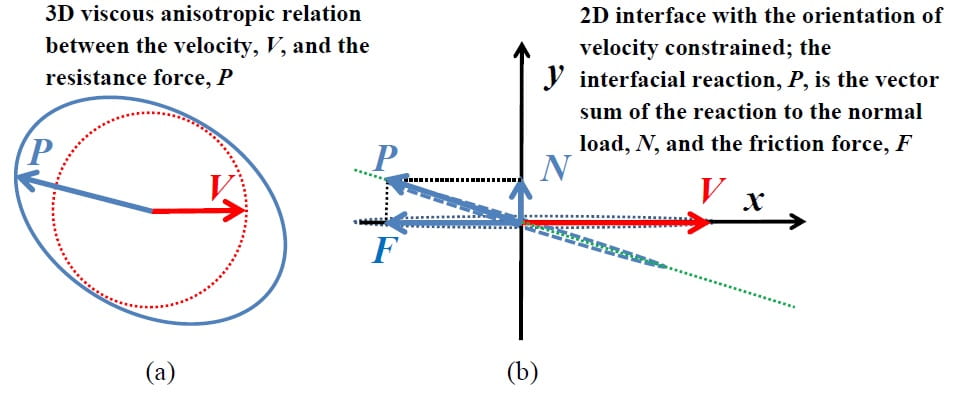For many years, I have been thinking about a mystery, related to dry friction. Friction is ubiquitous, and it is a universal phenomenon; however, the law of friction is not deduced from any general principles of physics. By “the law of friction” I mean the Coulomb-Amontons law of dry friction, which states that the friction force F = μN is proportional to the normal load force, with the coefficient of friction μ more or less independent of the normal load, N, the velocity of sliding, V, and the nominal size of contact, for a given pair of materials in contact.
Of course, there are various explanations of the friction law. Some are related to the fact that for most reasonable statistical distributions of surface roughness asperity height, the real area of contact is approximately proportional to the normal load. This is the so-called Greenwood-Williamson model, which has numerous extensions. Other explanations emphasize the plastic nature of contact or the fractal character of the surface roughness, for example, the Archard model. There are modifications of the friction law (e.g., the rate-and-state models with internal variables). Some physicists also state that the friction law is essentially incorrect, and that the coefficient of friction can vary significantly for the same pair of materials in contact.
Despite all this, the law of friction works, and none of the explanations are related to the fundamental physics laws, such as the Second Law of Thermodynamics.
Note that the law of friction is different from other approximate linear physical laws, such as the Ohm’s law of electricity, the law of viscous friction, Fick’s law of diffusion, or Fourier’s law of heat conduction. All these laws relate, in a linear manner, the cause (like the electrical potential, applied force, concentration or temperature gradients) with the effect (the electrical current, velocity of motion, mass and heat flow). In terms of the non-equilibrium thermodynamics, these are linear relationships between thermodynamic forces and thermodynamic flows. These linear dependencies can be viewed as fundamental, in light of Lars Onsager’s theory of non-equilibrium thermodynamics.
Dry friction is different, because its linear relationship is between the normal load and the friction force. The normal load is not the cause of friction, and it not a thermodynamic force in the sense of the non-equilibrium thermodynamics. It would be, therefore, desirable to deduce the law of dry friction from the law of viscous friction (which, in turn, can be treated as a linearized law of non-equilibrium thermodynamics).
I think I have invented a procedure of how to do this some 10 years ago, and I have published it, for example, in Entropy 2010, 12:1345 (see Eqs. 39-41 in https://www.mdpi.com/1099-4300/12/6/1345/htm ). In many cases, one can deduce 2D and 1D constitutive laws from the 3D laws by applying the asymptotic transition. This is true, for example, for the theory of elastic plates (2D) and rods (1D), which can be deduced from the 3D bulk elasticity equations using an asymptotic transition. A similar procedure can be employed to deduce the law of friction at an interface (2D) from the viscous friction in the bulk (3D).
The viscous friction is characterized by a viscosity tensor, which relates, in a linear manner, the friction force and the sliding velocity vectors. The orientations of these vectors in a general case do not coincide, for anisotropic viscosity. When the velocity vector rotates 360 degrees making a circle, the force vector would make an ellipsis, in accordance to the tensor relationship between them, as it is shown in the figure below.
In the limit of a 2D material, when the velocity vector is constraint, so that motion is possible only in the tangential direction to the interface, the force vector is forced to have a certain orientation. In other words, the ratio of the tangential-to-normal components is constant, which is exactly the case for the dry friction, F/N=const. Furthermore, in case of the asymptotic transition, the magnitude of the sliding velocity along the interface can be any number (zero-divided-by-zero type of undetermined value), which is again exactly the case of dry friction, for which , unlike for viscous friction, sliding velocity is not dependent on forces.

(a) In a viscous 3D medium, the applied force (P) and velocity (V) vectors do not have the same orientation. (b) When sliding velocity is constrained to be parallel to the interface, the tangential-to-normal component ratio of the applied force is constant. The red circle in (a) signifies the locus of velocity vector, while the blue circle is the locus of the force vector. In (b), the red circle transforms into the horizontal axis x, while the blue circle transforms into the inclined green line.
Of course, one can say that this simple procedure does not explain WHY the vector P has a certain orientation, and it does not predict what should be the value of the coefficient of friction. We just stated that viscous friction with an anisotropic viscosity tensor having a certain orientation will lead to the law of dry friction, when the limiting transition from the 3D bulk to the 2D interface is considered. We still do not know why it is anisotropic with a certain orientation, and we cannot deduce the orientation from properties of the materials involved. Furthermore, it may be difficult (although not impossible) to formulate this idea in the form of a hypothesis, which could be tested experimentally. However, I still think that this model is useful. The model shows that the dry friction law is consistent with the fundamental laws of physics, such as the dependencies between thermodynamic forces and flows.